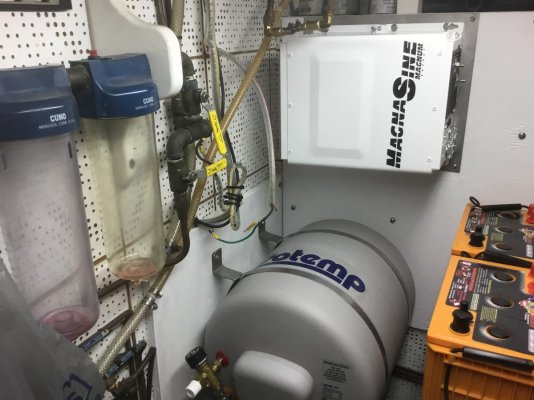Simi 60
Guru
- Joined
- Jul 1, 2016
- Messages
- 5,482
- Location
- Australia
- Vessel Make
- Milkraft 60 converted timber prawn trawler
New boat has a perfectly adequate HWS on board for when attached to a marina berth.
A Rheem household 140 litre with 240v supply
As we plan on actually using the boat and unattached we need an alternative.
The boat will mainly be used in warmer climates mainly with two people on board.
We have had boats before so are used to short showers so not much hot water required for showering, some months even cold showers will be the norm.
Main water usage will be hot water for washing up.
One thought was to use the existing tank as storage and try and set up a recirculating water supply getting heat from the primary engine when running and then kept warm by the genset when running for an hour a day while supplementing solar charging.
I think in reality this will not work.
On demand gas is considered, but laws in Australia mean that only certain systems meet approval so that will be a $1000 PLUS installation plus gas is not always readily available
That leaves small 240v and off engine systems.
I was looking at this would appear to be the simplest install once I remove the existing electric HWS as power and water are already there.
Duoetto 12Volt-240Volt Electric 10Litre Hot Water Heater
https://www.keoghsmarine.com.au/HOT...torhomes-RVs-Camper-trailer-Power-Motor-Yacht
Next was this unit and while it has some advantages it will be a more difficult install.
Kuuma / Force 10 24 Litre Water Heater
https://www.whitworths.com.au/main_itemdetail.asp?cat=133&item=93079&intAbsolutePage=
Any thoughts or is there something better I am missing?
A Rheem household 140 litre with 240v supply
As we plan on actually using the boat and unattached we need an alternative.
The boat will mainly be used in warmer climates mainly with two people on board.
We have had boats before so are used to short showers so not much hot water required for showering, some months even cold showers will be the norm.
Main water usage will be hot water for washing up.
One thought was to use the existing tank as storage and try and set up a recirculating water supply getting heat from the primary engine when running and then kept warm by the genset when running for an hour a day while supplementing solar charging.
I think in reality this will not work.
On demand gas is considered, but laws in Australia mean that only certain systems meet approval so that will be a $1000 PLUS installation plus gas is not always readily available
That leaves small 240v and off engine systems.
I was looking at this would appear to be the simplest install once I remove the existing electric HWS as power and water are already there.
Duoetto 12Volt-240Volt Electric 10Litre Hot Water Heater
https://www.keoghsmarine.com.au/HOT...torhomes-RVs-Camper-trailer-Power-Motor-Yacht
Next was this unit and while it has some advantages it will be a more difficult install.
Kuuma / Force 10 24 Litre Water Heater
https://www.whitworths.com.au/main_itemdetail.asp?cat=133&item=93079&intAbsolutePage=
Any thoughts or is there something better I am missing?


